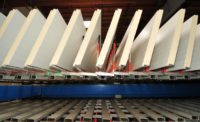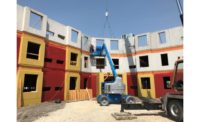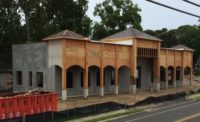The winds of change are upon us. These days it can be observed that building construction materials, techniques and designs are influenced by many drivers. This article discusses the use of spray-applied, medium density, closed-cell polyurethane foam (ccSPF) and compares off-site (in a controlled environment) applications with on-site spray application.
The exterior wall systems market size is projected to grow from $173.93 billion in 2016 to $278.82 billion by 2022. The market is projected to grow at a compound annual growth rate (CAGR) of 8.43 percent during the forecast period. The base year considered for the study is 2016, and the market size is projected from 2017 to 2022.
Precast concrete use is projected to top $20 billion by 2025 and yield a CAGR of between 8 and 10 percent between 2020 and 2027.
Concrete Construction
This is no surprise given the advantages panelized concrete construction offers. But how can we effectively insulate these panels?
The two project photos below show typical precast panels being installed and ccSPF applied to the back side before glazing units are also installed.
One option, structural insulated panels, incorporates a core thermal control layer sandwiched between two structural members. An alternative is to install the insulation (ccSPF) directly onto the back of the precast after the panel is placed in position. This approach has been used successfully for more than 30 years. It should be noted, the spray foam must yield a nonpermeable assembly with an installed thickness greater than 1 inch to achieve a vapor permeance of under 1 perm. Air barrier continuity is achieved using transition membranes at punched openings. The figure on the next page clearly shows the transition membrane and fully adhered, monolithic spray foam.
Today’s ccSPF systems have low global warming potential and easily exceed the above requirement at thicknesses slightly less than 1 inch. The design community must remember that each ccSPF formulation is unique and are encouraged to check the technical data of the specific system being installed on a particular project.
On-site application of ccSPF is relatively simple, but subject to a few critical factors. The climatic environment and application scheduling have significant impact. ccSPF can be successfully installed onto concrete in temperatures approaching 10 degrees Fahrenheit and well in excess of 100 degrees Fahrenheit.
ccSPF Application
As glazing units are not present during insulation application, the unconditioned outdoors can impact the work area. Industry best practice calls for the creation of a segregated workspace for the application of spray foam. This workspace will provide a physical barrier to entry into the workspace during spray operations, facilitate required ventilation of the workspace by defining the space and provide a defined area which can be conditioned if required. With the panels in place, the attachment points can be included in the thermal control layer to eliminate the potential for condensation and rusting of the attachment hardware. Hard-to-reach areas can be easily insulated once installed and the required fire stop material installed.
At the edge of the floor slab, ccSPF is applied directly onto the firestop and carried onto the back side of the panel in a single step. All ccSPF products used for this application exceed the requirements of NFPA 285 and testing can be conducted on proprietary assemblies specific to individual manufacturers. This allows the design community access to fully-tested and approved panelized assemblies through the various fire test listing services (UL, FM, etc).
In Canada, on-site quality assurance testing and reporting is mandatory. Applicators have been trained and certified to run thickness, density and adhesion tests at a prescribed frequency. The site quality assurance program is managed by an ISO-certified third-party quality assurance provider and is a component of each manufacturer’s federal product approval. Both the product standard and installation standard are referenced in the National and Provincial Building Codes. It is interesting to note, no such requirement exists in the United States—apart from the Air Barrier Association of America program. The need to reduce risk is a primary driver of the trend towards panelized construction in a controlled environment.
Unique products and designs incorporate high-performance insulation—closed-cell, ccSPF, applied directly onto the back of 2-inch-thick concrete panels integrated with steel stud framing members. The assembly is 66 percent lighter than traditional panels and framing systems.
The application of ccSPF onto the back of concrete panels within a plant before shipping to the jobsite for installation holds several advantages. Wells Concrete of Minnesota is one panel manufacturer who has investigated this option, working with a foam system manufacturer, Huntsman Building Solutions, to conduct in-depth testing and run lengthy product trials. They concluded that advantages offered by the application of ccSPF at their facilities adds significant value to their product offering.
Why ccSPF?
Tim Edland, director of research and development for Wells Concrete, identifies four key benefits of ccSPF. “There is benefit in being able to provide our clients pre-insulated panels. ccSPF provides a continuous thermal control layer once it is jointed on-site. The foam we use is an environmentally conscious choice with no ozone depletion, ultra-low global warming potential and high recycled content. And finally, it is highly efficient in thin layers—R-7.4 per inch.”
Edland adds, “The advantage to doing this in our facility are numerous. We control the production rate and scheduling, we institute our own quality assurance procedures, and we eliminate the environmental variables of on-site application.”
When applying an engineered approach to manufacturing, specific quality control measurements can be incorporated into the process. In the case of ccSPF applied to the back of concrete, the moisture content of the substrate can be monitored and the foam applied once a specific moisture content is reached. In-place (as applied) foam thickness can be monitored and deficiencies corrected immediately, density can be monitored, and adhesion of the foam to the substrate can be tested and confirmed to be above a pre-determined “acceptable” value. The finished panel can then be stored for final curing. Random, non-destructive adhesion tests can be conducted to confirm foam adhesion as the panel is shipped to the job site.
By incorporating high performance ccSPF into concrete panel designs, overall panel thickness can be minimized, saving space, and reducing weight and attachment requirements which result in a faster dry-in state for your projects. The thermal control layer is installed by trained professionals in a controlled environment under strict quality control requirements. The risk associated with insulation installation on site by an unskilled laborer, in the case of glass fiber, are minimized, and the potential for delivery of a truly effective, functional building envelope are maximized. Once we do that, usable space is maximized, occupant comfort is maximized, occupant retention is maximized, attendance goes up, and workplace illness is reduced through improved indoor air quality.
It has been said many times, by many highly-respected individuals, “It all starts with the building envelope.”










Report Abusive Comment